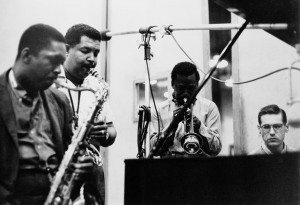The last two posts were about music the old record stores would have categorized as “classical” music. I now want to move over a couple of aisles in the store and talk about an album that is on the Jazz shelf. It should be on everyone’s Jazz shelf. For some people it is the whole Jazz shelf! I’m talking about the famous album Kind of Blue from Miles Davis and his legendary sextet group.

Jazz is a pretty broad category of music that applies to everything from Louis Armstrong and his “Hot Five” and “Hot Seven” groups, to Count Basie’s big band, to Ornette Coleman’s Free Jazz and so much more. Miles himself was an innovator and changed approaches many times during the decades of his career. His early professional career in the late 1940’s included work with Charlie Parker, a pioneer in the style of Jazz that came to be known as bebop.
Bebop often features a small group of musicians playing at very quick tempos and giving us blazing fast solos . The players use upper extensions of the chords, and pack in multiple chords into each bar. They sometimes substituted some of their own chords on top of the existing harmony. Bebop was definitely a vehicle for the soloist, who would improvise over tunes often based on blues chord changes or the 32 bar form called rhythm changes (after “I’ve Got Rhythm”).
Here is a recording of a tune called “Donna Lee” from 1947 featuring Charlie Parker on alto saxophone and Miles Davis on trumpet. (Email readers click here)
To deal with frequent chord changes at fast speeds, players often developed their own ideas and “licks” that they practiced ahead of time. They had these ready to go for when common harmonic patterns appeared in the tune they were playing. This brings us to one of the novel things Miles did with the Kind of Blue recording session. There was absolutely no rehearsal for the recording, and the players did not know what they were going to play that day. Davis showed up with just ideas on scraps of paper. Unlike the bebop example above, the tunes on this record take a modal approach to improvisation. This modal approach used long stretches of music on only ONE scale or mode. The tempos are more relaxed and the tunes are simpler and sparse. This forced the players away from any of their practiced “licks” and made them improvise completely differently. Listen to “So What”, the first tune on the album. After the bass solo introduction, the music lingers on the same chord for 8 and 16 bars at a time. (Email readers click here)
How could this possibly have worked? Well, Miles started with one of the greatest jazz small groups every assembled: John Coltrane on tenor sax, Julian “Cannonball” Adderley on alto sax, Paul Chambers on bass, Jimmy Cobb on drums and Bill Evans on piano. The group had worked together and recorded together before. The players were all great players by themselves, but also complemented each other. Compare the first solo (in “So What”) with Miles on trumpet with the second solo with Coltrane on tenor saxophone. Miles plays a cool, relaxed solo with plenty of space in between melodic phrases. Coltrane is using a little of his “sheets of sound” approach where he plays sweeping runs of whole scales trying to fit in everything at once. (Later on in his tenure with Miles, Trane would play extremely long solos and said “I don’t know how to end it”. Miles reported replied in his gravelly, permanently hoarse voice “Try taking the horn out of your mouth”)

Kind of Blue is likely the best selling Jazz album of all time. There were problems with some of the releases. Some of the early LP’s reversed the names of “All Blues” and “Flamenco Sketches” on what was side two. Some releases had side one at a pitch level that was maybe a quarter step high, due to one of the master tapes running in a machine that was slightly off speed. This pitch issue had caused me a few headaches in my teenage years as I tried to play along with the record and could never push the tuning slide on my trumpet in far enough to play in tune with the music. I didn’t know at the time there was an issue with the recording. I probably owe my parents and neighbors an apology for the clashing sounds as I tried to practice with my copy of Kind of Blue.
Thankfully, all those problems have been corrected, and it is safe to go out and get your own copy of Kind of Blue. Whether you let some young trumpet student try to play along is completely up to you.
-Rich

My daughter is currently learning to play the trumpet. Right now I’d settle for slightly pitchy 🙂
Thanks for the historical and theoretical depth of this post. I love the emphasis on the process of music, and innovative ways of thinking about music. I learned a lot, thank you.